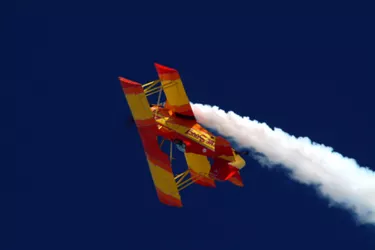
Aerobatic or stunt flying offers a varied and challenging career. Not for the faint-hearted, aerobatic flying requires excellent coordination, reflexes, nerve and highly developed professional flight skills. Aerobatic flying requires the pilot to execute maneuvers not used in normal flight. Performed with airplanes, gliders and helicopters, aerobatic pilots execute amazing avionic manipulations for training, recreation, entertainment and sport.
Income
Video of the Day
The 2010-11 Edition of the United States Department of Labor, Burearu of Labor Statistics, Opportunity Handbook reports that in 2008 the median yearly income of commercial pilots was $65,340. The middle 50 percent of pilots earned between $45,680 and $89,540. The lowest 10 percent received less than $32,020 and the highest 10 percent earned more than $129,580.
Video of the Day
Job Description
Many aerobatic pilots own their own plane and supplement their income working as aerial application pilots (crop dusters) or flying advertising banners for pay. Aerobatic pilots fly in competitions to earn flight hours and cash prizes. Some are members of teams of aircraft that present exhibitions at fairs and aircraft shows. Many experienced aerobatic pilots are certified flight instructors and earn additional income providing private lessons to student pilots.
Qualifications
Aerobatic pilots must be in good physical shape, have excellent reflexes, coordination and hearing. Vision must be 20/20 with or without prescription lens. To obtain a pilot's license, candidates must pass a strict physical examination by a FAA-approved physician. Pilots must not have any physical or mental handicap that could impair function or the ability to fly an aircraft. Above average communication skills, both written and oral, are integral to the duties of a pilot. Although a degree is not required to obtain a pilot's license, the majority of commercial pilots have a bachelor's or master's degree in mechanical engineering, flight engineering or aerodynamics.
Training and Licensing
The majority of aerobatic pilots receive their training while serving in the United States Armed Forces. Military pilots are taught aerobatics as a way of developing flight skills and for tactical response in combat. Others who wish to pursue a career as an aerobatic pilot attend flight school and obtain a commercial pilot's license. They often obtain additional aerobatic flight training from special aerobatic flight schools. The International Aerobatic Club provides a comprehensive guide to aerobatic flight training schools around the world.